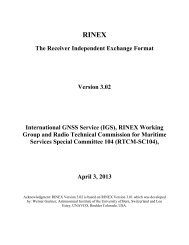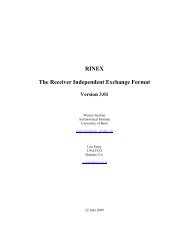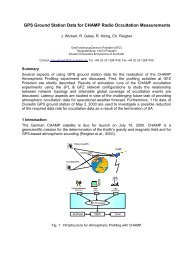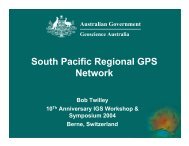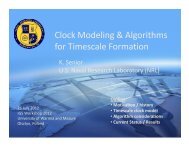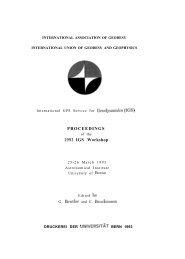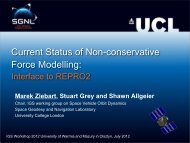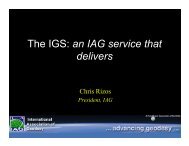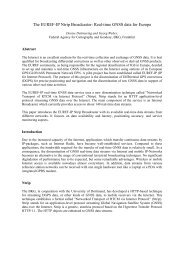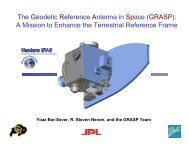IGS Analysis Center Workshop - IGS - NASA
IGS Analysis Center Workshop - IGS - NASA
IGS Analysis Center Workshop - IGS - NASA
You also want an ePaper? Increase the reach of your titles
YUMPU automatically turns print PDFs into web optimized ePapers that Google loves.
problem satellites, DRAO, one of the most reliable station in the whole <strong>IGS</strong> network developedhardware problems, resulting in data loss on January 28,29 as well as shorter observation periodsfor January 24 and 27. For these reasons the DRAO data for Jan 24,28 and 29 was not used in theEMR orbit computation. All the available data sets (including the January 24 and 27 data atDRAO) were used in this baseline test. It should also be noted that two stations ALGO and YELLwere held fixed in all the orbit computations along with additional 10 globally distributed stations.So the YELL-ALGO baseline results cannot be considered representative of achievablerepeatability.* Baseline results are summarized in Table 4.1. As one can see the combined orbits compare quitewell with the best individual orbits. It was not expected that the EMR orbits would perform betterthan the combined orbits, since the baseline software used is different and independent from theEMR orbit generation. This maybe due to the fact that the EMR orbits favor N.A. and Canada inparticular by including data from six Canadian stations. The situation maybe completely differentin other parts of the globe. The North baseline component is the most stable, the formal errorsranged from 1.5mm to 2mm, and thus is well suited to check orientation (EOP) errors at or belowthe 0.5mas (2.5ppb) level. From Table 4.1 it is apparent that the orientation for the combined orbitsand EMR is at the 4-5mm level which corresponds to about 0.3mas at 3000km. The lengthrepeatability is at the 3- 4ppb level for both combined and the best orbits. The formal length sigmasvaried between 1 ppb for YELL-ALGO and about 2ppb for the remaining two baselines. Asmentioned before, YELL-ALGO repeatability is not representative of achievable precision, butDRAO-ALGO and STJO-ALGO sigmas are meaningful. Removing the two most problematicdays (January 17 and 27) results in significant scale improvements for the longest baseline(DRAO-ALGO), down to about 2ppb. Also listed in Table 4.1 are the height sigmas and they arealso lower for the combined and regional orbits. Finally, the combined orbits of the fiist type (<strong>IGS</strong>)appears to be slightly better here, at least as viewed from North America. This may be due toproblems on Jan. 22 mentioned in Section 3 and also due to the fact that <strong>IGS</strong> orbits employs the L1norm which is supposed to be less affected by marginal and outlier orbits..51




